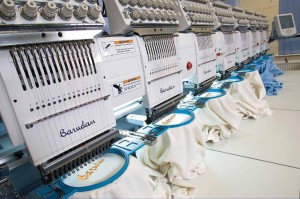Painting by Needle & Thread
Em-broi-dery: The art of forming decorative thread patterns by hand or machine, has been around since man began to wear clothes. Stitching to join animal skins together fostered the development of hand-sewing techniques and led to the decorative possibilities of embellishment with thread, beads, shells, gems, and metals.
Elaborately embroidered clothing has been a mark of wealth and status in many cultures.

Rich traders and merchants were willing to pay large sums of money for the luxury of embroidered clothing. Traditional techniques were passed through generations in diverse civilizations from the Middle East to Europe to Mexico. Professional workshops and guilds, called “Opus Anglicanum” or “English Work” arose in Medieval England and were famous throughout Europe for their exquisite stitching.
Fast forward several hundred years. Shuttle embroidery, based on the principles of the newly invented sewing machine, revolutionized the industry and led to the development of hand-powered embroidery looms in the 1870s. Swiss inventor Isaak Groebli is credited with the first practical embroidery machine, which utilized the combination of a continuously threaded needle and shuttle containing a bobbin of thread. The shuttle itself looked similar to the hull of a sailboat. “Schiffli” means “little boat” in his native language, so his machine came to be known as a schiffli machine.
 Barudan, a leading manufacturer of advanced embroidery machines, developed the first computerized machine in Ichinomiya, Japan in 1977. Computer technology, of course, has revolutionized the industry once again. Contemporary digitization software redraws any image in thread, allowing for exacting reproductions of artwork or logos. Different types of fill add texture and design to the finished work and mimic the elaborate hand-embroidery of the past.
Barudan, a leading manufacturer of advanced embroidery machines, developed the first computerized machine in Ichinomiya, Japan in 1977. Computer technology, of course, has revolutionized the industry once again. Contemporary digitization software redraws any image in thread, allowing for exacting reproductions of artwork or logos. Different types of fill add texture and design to the finished work and mimic the elaborate hand-embroidery of the past.

Embroidered logos, monograms, business shirts or jackets and team apparel continue to make history today, giving businesses many options to develop their unique brand image. Physical marketing is a cost effective, dimensional, and durable way to catch your clients’ eyes and capture imagination.
Imagine what we can do for you.

